Nikon has introduced a new mirrorless system (DSLM) along with two full-frame sensor cameras and three matching lenses, to begin with. There is also an adapter that adapts almost any F-mount lens to the new Z-Mount. I had the opportunity to try out the Z7 and Z6 cameras in advance and will tell you my first impressions here. I will add to this article as soon as I have further information / experience.
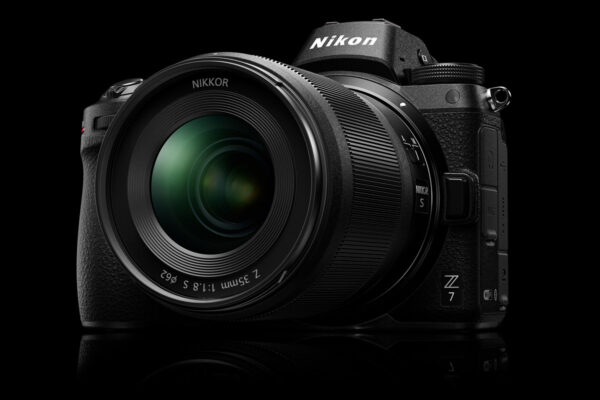
Nikon enters the field of mirrorless full-frame DSLM cameras late, but with the ambition to get it right from the start and learn from competitors’ experiences. I, for myself, have always been a DSLR fan and so far none of the mirrorless cameras available really convinced me. For now, systems with full-frame sensors have been limited to Sony and Leica. Sony has invested a lot in this category, but I could never really get used to them, especially because they’ve always had some disadvantages especially for timelapse photography. And Leica is not the kind of camera that suits my photography.
A bit of history
Why mirrorless? Well, the mirror in the DSLR cameras was invented back in the analog times, to enable the photographer to see exactly the picture, which comes through the lens though the viewfinder. Previously, there were the rangefinder cameras which work with two different optics – one for the viewfinder and one for the film. The problems here are obvious: the focal length of the lens for example is not reflected in the viewfinder. Also the viewfinder does not show exactly the image that the lens captures. And so on. I admire people who volunteer to work with this technique even today, for example on Leica… 🙂
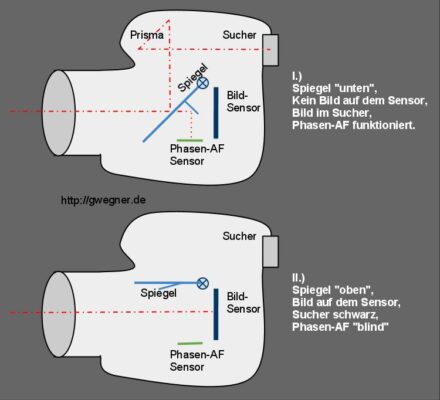
mirror below / mirror above
The introduction of the DSLR back then was a revelation. For the first time the image was directed through the lens onto a mirror, passes through a prism and can then be viewed through the viewfinder. When the shutter is released, the mirror flips upwards and the same image ends up on the film or sensor.
I can still remember exactly how I looked for the first time through the viewfinder of a DSLR (after knowing only rangefinder cameras from my parents) – wow, that was cool. I could really see the depth of field in the viewfinder and would capture exactly the same section on film, that I saw in the viewfinder. I could see the effect of focusing and zooming the lens was also instantly visible in the viewfinder.
The DSLR technology has proven itself and held until today, even if today there are other techniques to get the same lens image both into the viewfinder and on the sensor. Specifically, this is done by capturing the image on the sensor straight away and implementing an electronic viewfinder which displays the sensor image via a display in the viewfinder. Unfortunately, it took years for these viewfinder displays to outgrow the “video camera look” and deliver almost the same quality as an optical viewfinder.
In addition, such electronic viewfinders also offer additional advantages. Information, such as the histogram, sharpness areas, menu settings etc., can be easily superimposed into the display. In addition, this eliminates the large mirror construction and thus the need to always produce a mechanical sound when taking pictures. Wedding and theater photographers can tell a story about this.
Anyone who has once observed the mirror of a D5 when triggered with 12fps, has seen the technical masterpiece behind this construction and the masses that are moving there at breathtaking speed.
With todays’ advances in display technology, the advantages of the optical viewfinder get smaller and on the other hand, cameras can fully exploit the advantages of the electronic viewfinder and achieve the same acceptance among photographers. This is also shown by the current market shares. Many buyers are apparently ready for the change.
Market share
The market share of mirrorless sales around the world are at 30%, according to Nikon. In Germany alone, apparently even at 50%. Time for Nikon to enter this market.
But for this to work, I think, it’s not enough to be as good as the competitors – Nikon needs to implement unique selling propositions that differentiate their solution from the others.
Nikon seems to be pretty aware of this. I was very curious to see, whether they succeeded.
Under strict secrecy, Nikon presented the new Cameras before the release date to some press colleagues and myself in Hamburg. Those were still pre-series models – but after all the “rumors” in the internet, I was more than happy to finally have the opportunity to see the cameras, to take them in my hands, to try them out.
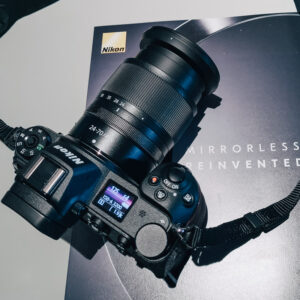
First of all, I was interested in Nikon’s goals for the new system. According to Nikon, the main goal for their new mirrorless system is nothing less than combining the advantages of the DSLR and DSLM systems.
Let’s take a look at the obvious and unique selling points of DSLM cameras today:
- Smaller and lighter than DSLR
- Better video capabilities (such as autofocus for video, stabilizer in the camera body)
- The potential of an electronic viewfinder (such as histogram, image review, etc. directly in the viewfinder)
- Faster image sequences by eliminating most of the mechanics (mirrors)
- Silent shutter release
In addition, Nikon now wants to establish the proven advantages of the DSLR cameras also in the new system:
- Ergonomics with a deep grip and good, familiar handling and usability
- High reliability
- Weather protection
- Compatibility with existing F-mount lenses
- Adopting the proven menu and user interface

The cameras
There will be two cameras called Z6 and Z7.
- The Z7 is a 46 MP camera capable of shooting 9 frames per second and covering an ISO range of 64-25,600. It has got 493 AF fields.
- The Z6 has 24 MP, takes 12 frames per second, covers an ISO range of 100-51,200 and has 273 AF fields.
Otherwise, the cameras are the same – they do not differ feature wise. The following statements therefore refer to both cameras, unless I explicitly point it out.
Both cameras have a new processor, the sensors were developed by Nikon and are again BSI (backside illuminated) sensors, for better noise performance.
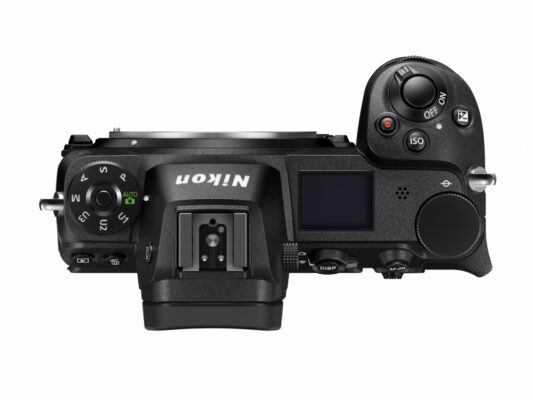
Look and Feel
Thankfully, for the Z cameras, Nikon has refrained from jumping on the “retro” train as others do. The Z6 and Z7 look like real Nikon cameras, in a beautifully updated look. Especially the deep, ergonomic grip makes holding the camera feel very good. This follows up to the redesign in favor of deeper grips, which Nikon has already introduced for the DSLR cameras in the last years.
The electronic viewfinder stands out quite a bit, this is due to the complex optical design, which ensures a very large and bright viewfinder image. The tester in our preview round who wear glasses, were also very pleased. In addition, the deep viewfinder effectively prevents nasal wiping on the display.
The buttons on the back are all mounted on the right side in a tidy layout.
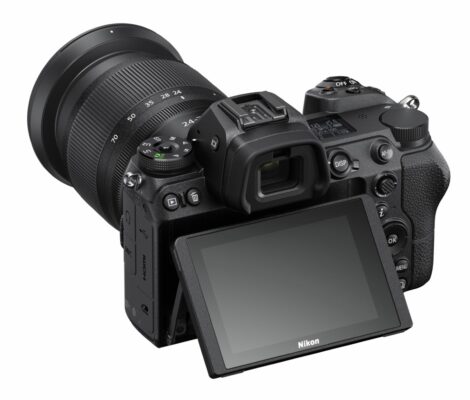
Monitor, viewfinder and shoulder display
Shoulder display
Let’s start with the shoulder display: it’s not an LCD but an OLED display, which looks really chic and modern compared to the LCDs of other cameras. As usual, you can find the most important settings (shutter speed, aperture, etc.) displayed on the top of the camera. The display can be switched off.
Monitor
The monitor is a 3.2″ flip-up display, similar to the D850. It’s an LCD with touch capabilities and offers also the very high resolution coming from the D850.
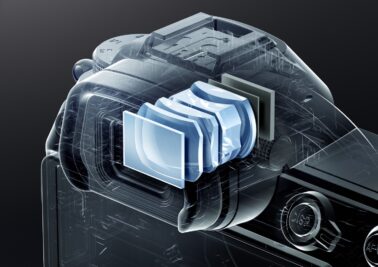
Electronic viewfinder
The electronic viewfinder is the best I’ve ever seen in a mirrorless camera. It comes extremely close to an optical viewfinder and of course offers all the benefits of an electronic viewfinder.
With 3.6 million pixels it has a very high resolution. I could not detect any pixels, flickering, streaks, or other negative effects when testing, neither in daylight nor in artificial light.
In short: this viewfinder impressed me. It sits behind a very elaborated optical design, which leads to a very large viewfinder image (0.8x, larger than that in the D850), a 100% coverage is a matter of fact anyway in an electronic viewfinder.
Auto Focus
The autofocus of the Z6 and Z7 is a combination of phase AF and contrast AF. In my tests it performed very fast and accurate. The big advantage over a DSLR is, that the focus fields go to the edge. There are 493 focus fields on the Z7 and 273 focus fields on the Z6. That’s really a lot and allows fast and accurate focusing.
I could not tell the difference when focusing with Z-mount lenses versus with F-mount lenses, which were connected via the adapter. Also focusing with third-party lenses (I’ve tested the Sigma Art 18-35 f/1.8) worked very well.
Video
The Z6 and Z7 cameras have a built in 5-axis stabilizer that is said to be able to gain 5 f-stops. They can record in 4K, also with focus peaking (which doesn’t work on the D850).
The Z6 uses pixel binning in 4K, which means, it uses all of the awailable sensor pixels to create the 4K image. The Z7 uses only the necessary pixels, needed to create the 4K image. This seems to be another difference between both cameras, but it should only be of interest for people that are very deep into video recording.
Also a zebra function is implemented. In addition, the Z6 and Z7 can output a 10-bit video signal via HDMI. In Full HD it can record 10 bit to the memory card also.
The cameras can record video in a flat N-log profile (new at Nikon!) and also record a time code (I could not get any further information on that yet).
In contrast to the Nikon DSLR, the autofocus in video mode performes quite well on the mirrorless Z-cameras. A combination of phase and contrast autofocus is used. The speed of the autofocus response can be configured. In practice, this should allow a gentle focus shift when the focal plane changes. To really say how practical this new video autofocus is, I still have to do some more tests. The first impression was very good.
WiFi / Snapbridge
You can imagine my excitement, when I learned and saw that the Z6 and Z7 provide open Wi-Fi, like myself and many others were asking for since Nikon started to deliver Cameras with Snapbridge and removed the option for open Wi-Fi.
Open Wi-Fi now is back in the Z6 and Z7! This means it will be possible to use 3rd party control apps (as soon as the apps support the cameras). Snapbridge can be used optionally.
Weather-sealing
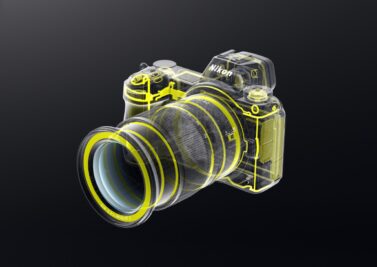
The camera sealing is on the same level as in the D850. Nikon focuses on robustness and suitability for harsh conditions with the Z6 and Z7.
Memory Card
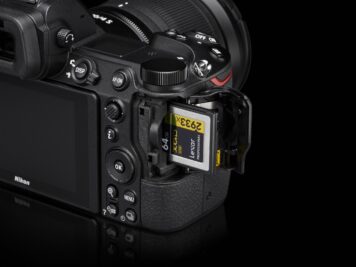
Unfortunately, there is only one card slot and that is for xQD cards or CFExpress. In other words, all those who do not yet have an xQD card must get one. Once the new CFExpress format is available, those cards will work in the Z6 and Z7 as well.
I think that’s a bit of a surprise, because the SD card format is very common and with SD Express already has a fast and backward compatible successor.
On the other hand, the design of the xQD / CFExpress cards is much more stable and still a bit cheaper than SD Express.
It’s clear that Nikon had to switch to one of the fast formats for the fast-paced new cameras – normal SD cards are probably not fast enough to write 46 MP RAW files at 9 frames per second. The decision for one or the other system had to be made. Unfortunately, no one can really foresee, in which direction the memory card market will develop in the future. But as a consumer, I’m not a fan of a two-pronged approach. Currently it means, that I have to think of two card readers, can not easily swap cards between cameras and have to buy new cards.
Some will probably be disappointed, that only one memory card slot is installed. Personally, it does not bother me that much, but the backup argument is a strong one for professional photographers.
User Interface / Menu
The menu is based on the proven menus of Nikon cameras. Only the font and the symbols were modernized and look cool. I like it. And I think it was just the right decision not to throw everything overboard for the new camera system and implement a completely new user interface.
There is also an i-Menu, which can now be even configured individually. Great!
I also really liked that you can configure the focus ring on the new Z-lenses to be used for setting the aperture or exposure compensation. That’s outstanding: you look through the electronic viewfinder and change the brightness of the image by turning the ring on the lens!
Sometimes it’s the little things that make a big grin appear on the tester’s face! 🙂
The menu can also be operated via the touchscreen. Unfortunately I have to give the same criticism here again as on the D850. At least in the pre-production model, the Z6 and Z7 touch function in the menus is implemented in such a way that putting down the finger to scroll already selects the underlying menu item. That’s strange and not what the user expects. From a usability point of view, this is simply implemented in a wrong way and counteracts what users are used to from other touch user interfaces (for example, smartphones). It’s a pity that Nikon didn’t fix this in the new generation of cameras.
When navigating through the pictures, zooming, etc., the touch screen works quite well.
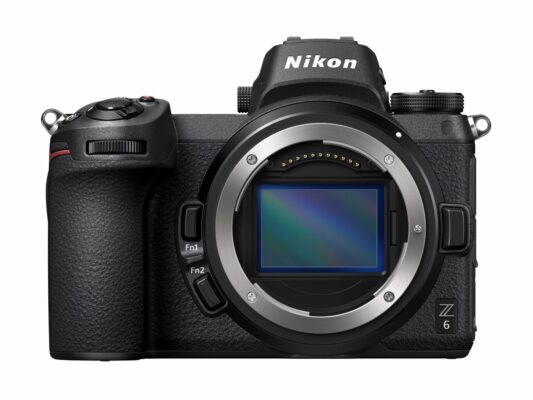
The Z-mount
With the new cameras, Nikon replaces the F-mount after 60 years and introduces a new, more modern and much larger mount called Z-mount.
This is directed to the future. Not only does Nikon now offer the largest mount diameter of all 35mm cameras (55mm inner diameter), but also the shortest distance between sensor and mount (flange distance). Nikons goal is to be able to develop new optical possibilities for even better lenses with the larger mount diameter and smaller flange distance.
The flange distance is only 16mm for the Z-mount (for comparison: Nikon-F: 46.5mm, Sony E: 18mm).
For example, according to Nikon, with the F-mount the maximum aperture for lenses is f/1.4. Faster lenses are now possible with the Z-mount. Furthermore, the Z-mount should also allow the construction of smaller and lighter lenses.
In addition, the new Z-mount makes it technically possible to connect almost any lens of other brands with a corresponding adapter. An adapter for lenses with F-mount has already been introduced by Nikon.
According to Nikon, the extremely large mount enables them to build extremely fast lenses, a 55mm f/0.95 will be announced very soon.
New Z-Mount Lense
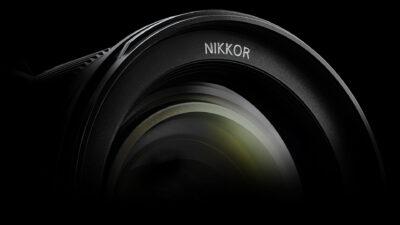
The first available Z-mount lenses will be a 24-70 f/4 and a 35mm f/1.8. Shortly thereafter, a 50mm f/1.8 will be presented. These lenses, especially the primes, are relatively lightweight and are said to have excellent optical quality and be significantly sharper on the edges, than premium f/1.4 lenses of competitors.
The lenses look chic and modern, they are not ultra-small, but also not too big. Overall, the prime lenses in particular make an excellent impression and the picture quality also seems to be very good. More detailed tests will follow.
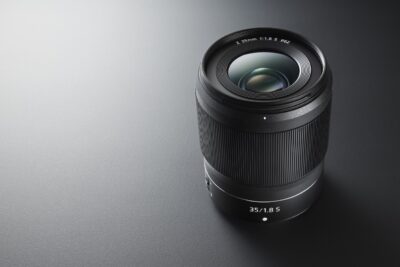
The F-Mount Adapter
Right from the beginning an adapter will be available, which makes it possible to connect almost all lenses with the “old” F-mount the the Z6 and Z7 cameras. That includes 363 Nikon lenses alone. In addition, many third-party lenses will work on the adapter.
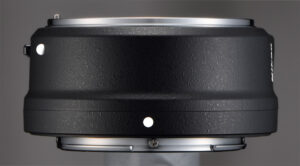
I was able to test the adapter with a Nikon 24-70 f/2.8 and also connected my Sigma 18-35 f/1.8 (DX). Both lenses showed no difference to the native autofocus on a DSLR. Even the very farthest focal points of the Z6 / Z7 (which are much further on the edge than the focus fields of a DSLR) have worked perfectly.
It is also very nice that the adapter is surprisingly light. This, and the ease with which it works makes it an indispensable tool to connect all F-mount lenses to the new cameras. Adapters for other systems will surely follow, presumably by third-party manufacturers. One can only hope that they will work just as well. Technically, the extremely shallow flange distance allows an excellent adaptability of foreign lenses.
All AF-S and AF-P lenses should work with the Nikon F adapter at full autofocus speed. Older lenses which require an in camera autofocus, can only be focused manually (with focus-peaking) as the cameras do not have an AF motor installed.
For VR lenses, the VR of the lenses works together with the stabilizer in the camera, which should increase the stabilization effect.
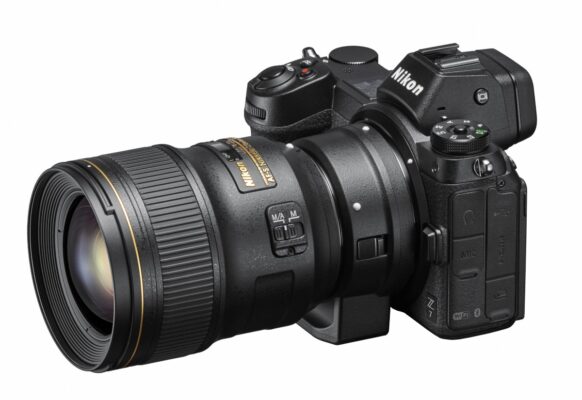
Nikon F-Mount lense with Z-Mount Adapter
Connecting DX Lenses for APS-C Cameras
An APS-C lens (DX, tested with the Sigma 18-35 f/1.8) as usually automatically switches the camera to DX mode, the DX image field will be scaled to cover the entire viewfinder and a small DX symbol is displayed in the upper bar in the viewfinder. The only effect of using DX lenses on the Z6/Z7 camera is that the resolution of the captured image is correspondingly lower. Otherwise, DX lenses work excellently on the new cameras also, since the viewfinder image is automatically scaled (in a DSLR, the usable viewfinder image is only the small DX frame in the middle of the viewfinder).
Power
For power supply, Z6 and Z7 rely on the proven EN-EL15 batteries, which are also available in a variety of former Nikon DLSR cameras. such as the D850, D7500, D500 etc… I think it was a very good decision from Nikon to stay with this widespread battery type.
I could not test the power consumption yet, but pre-series tests are said to have come to around 800 pictures with one battery. This is of course much less than with a DSLR with the same battery, but of course the reason is the electronic viewfinder. This can be compared with working permanently in live view on a DSLR. However, on the Z6 and Z7 you can turn off the electronic viewfinder and the display completely.
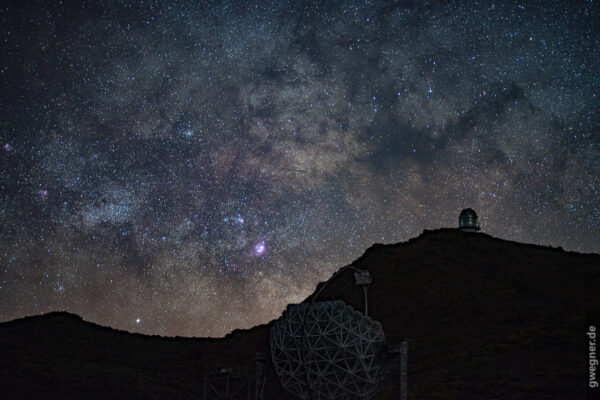
My first impression for astro- and time-lapse photography
One of the most important additional features on the Z7 and Z6 is, that the electronic viewfinder and display can be switched off completely with the single click of a button on the left side of the viewfinder without affecting the other function of the camera. That’s the feature that time-lapse and astro photographers miss on other mirrorless cameras. This means that the camera can be operated in a dark and energy-saving manner for time lapse shooting with external triggering – even in silent mode. Unlike the D850, which allows silent mode only with either the built-in interval function (which does not allow camera control) or live view (with the display enabled), the Z6 and Z7 can be triggered by an external remote control silently while the displays are all turned off. In this mode, the power consumption should be limited and allow significantly more than the 800 images mentioned above. As soon as I have the opportunity, I will of course test it.
Via the undongled WiFi I was able to connect the camera directly to my Smartphone and use qDSLRDashboard to control the camera. LiveView is not working yet, but this will forsure be supported with one of the next qDDB updates. The LRTimelapse page however, with the possibility to make the so-called “Holy Grail” transitions, is already usable! Thus, with the Z6 and Z7 cameras a big limitation for the time-lapse community has been removed!
Availability
Nikon claims, the cameras will be available in the fall of 2018. The Z7 will first be available, the 24-70 zoom lens and the 35mm f/1.8 lens and F-mount adapter.
Before Christmas, the Z6 should be available as well along with the 50mm f/1.8 lens.
For 2019, further lenses are planned, like the 58mm f/0.95 as well as some premium fixed focal lengths. Also standard, telephoto and wide-angle zooms are planned.
My conclusion so far
As the first camera manufacturer so far, Nikon has actually managed to change my “don’t need feeling” towards mirrorless cameras. But what’s more: they created a pretty significant “need to have” feeling for me.
The new cameras just feel good. They offer great ergonomics, have a high-quality, professional housing and look modern. And all this without throwing old virtues overboard. In addition, they are light and handy, but without feeling like “toys”. You always have the feeling that you have a professional camera in your hand.
The menu and usability is well done: it looks more modern, but any Nikon photographer will feel comfortably immediately. The same applies to the buttons on the camera or the i-menu, which is now even customizable.
The electronic viewfinder for the first time gives me the feeling that the advantages of such a system really outweigh those of an optical one without sacrificing joy of shooting. Taking pictures through this huge viewfinder is fun. The same applies to the flippable display, which is the ideal complement and no less than the best display on the market – taken directly from the D850.
Also, the silent shutter release is of course something that basically everyone would like to have, especially if it is just there and can be turned on and off at any time. For wedding and stage photographers this is a very important feature.
Nikon taking the step towards mirrorless technology has certainly been the right decision. The fact that they made an initially unpopular decision to create a new mount after 60 years, shall open up completely new optical and technical possibilities. The F-Mount adapter, which is available from the start and works so smoothly and transparently, is an indispensable tool. This makes the transition extremely easy for any photographer. It really is a bit like the best of both worlds.
Jumping on the train “Mirrorless” quite lately in my opinion will serve Nikon much more than cause any harm. I have the impression that Nikon has considered very carefully, how they want to position themselves on the market and also looked very closely at the choices which are already available, and where they could improve and create unique selling propositions.
Of course, the open Wi-Fi really makes me happy, and shows that Nikon actually listened to their users. My open letter has reached and been approved by thousands of photographers. And those have not only been time lapse, astrophotographers and nerds interested in an open Wi-Fi network, but also many other users of Nikon cameras. Nikon listened, understood and decided that they did not want to disappoint this audience. Chapeau! Snapbridge has also outgrown its infancy and offers the possibility to quickly upload a picture to the mobile phone for social media sharing for example. Both together lead to a camera with good connectivity, which hardly leaves anything to be desired in this regard.
The possibility to switch off the displays of the camera completely with a simple push of a button is as simple as ingenious. This helps extremely to save battery and to prevent the constant illumination of the camera in low-light environments. For me such details show that the practical experience with the new technology “mirrorless” had to be made first. And personally, I prefer that a manufacturer waits a little longer and then delivers a mature product to the market, not forcing me to be an early adopter.
The video functions also promise to deliver. Finally a built-in 5-axis stabilizer. In my tests, the camera has really felt extremely steady while filming. This, in conjunction with the significantly improved autofocus in video mode, focus-peaking even with 4K, zebra and a flat profile log, 10bit HDMI-Out etc. The Z6 and Z7 could turn out to be a real alternative to Lumix, Sony and Co even for ambitious videographers.
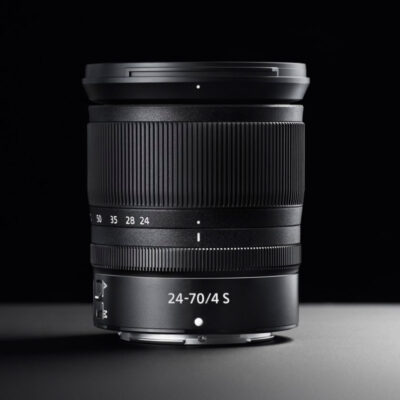
The new lenses leave a very good impression. The picture quality seems to be great and they look and feel good. However, they are neither particularly fast, nor particularly small, nor particularly cheap. Nikon says they did not want to compromise on image quality and that high end lenses will follow. I think I would have wished for something a bit fancier here, maybe a particularly small pancake, with the potential for a small and lightweight reportage camera.
I realize, of course, that Nikon can not release a completely new camera system with two cameras, an adapter plus a large lens park all at once. For the start, I think the 3 announced lenses serve a relatively broad audience – and those who think that these lenses are still too expensive or too slow can just take the adapter and stay with their existing lens park – which will not perform worse than on a DSLR. The fact that the adapter is so light, makes it easy to just use it. However, he sets off the lenses about 3cm from the mount – that’s exactly the 3cm, which the F-mount is further away from the sensor than the Z-mount.
I know that sounds all quite positive from my critical mouth. I’ll definitely need more time in the field with the cameras to possibly find one or the other thing. So far I’m impressed. Compliment to Nikon! Now I am really looking forward to testing the Z7 or Z6 in more detail soon.
Oh yes – one more thing: Z7 or Z6?
It is nice that both cameras only differentiate in the sensor (and in the price). For those looking for the last ounce of ISO performance, the Z6 is probably the right camera. For those interested in high megapixel, it would be the Z7. I also find it extremely difficult to set a preference. For timelapse and astro I would probably go for the Z6, unless I need 8K resolution. Preferably both… But now they first have to become available… 🙂
And you?
How do you see the step from Nikon to the mirrorless market? How do you feel about the announcements? Do you want one? Let me know in the comments!

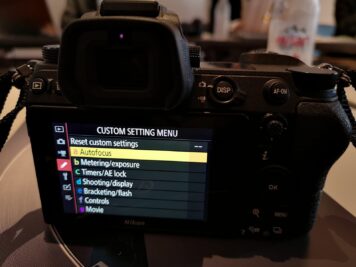
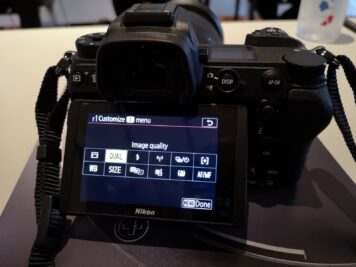
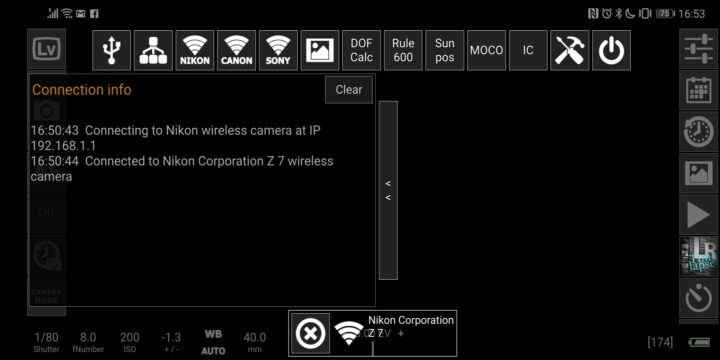

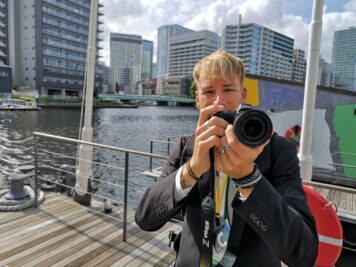
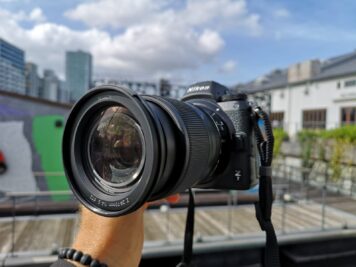
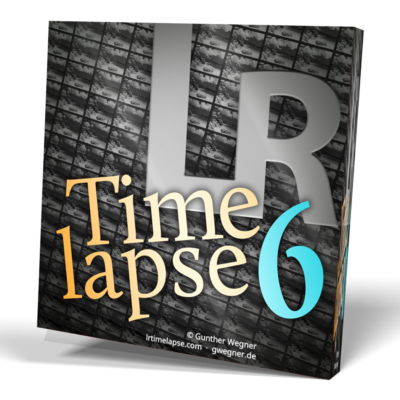
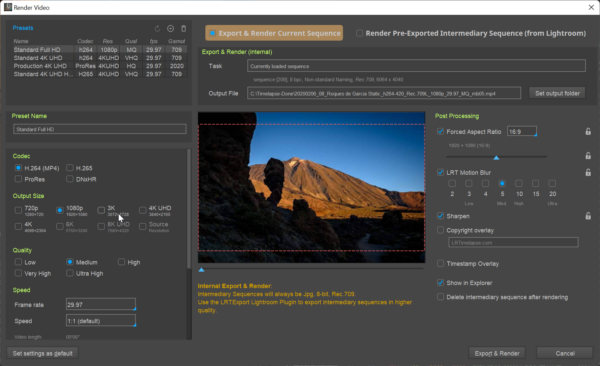




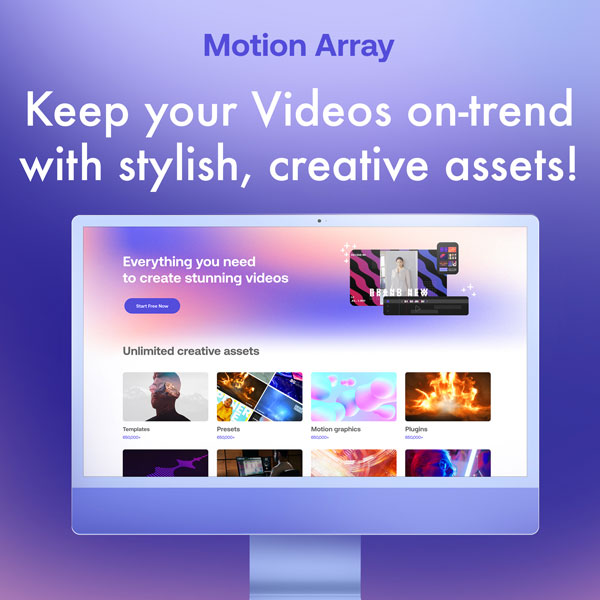

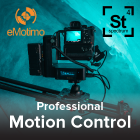
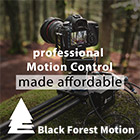
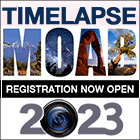
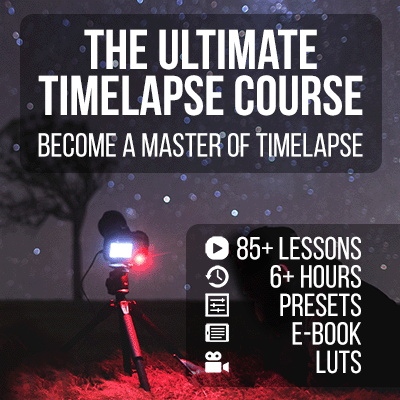
As usual – great reporting and review.
Günther, you mentioned that you intend to “add to this article as soon as I have further information / experience”.
Almost 5 Years later, I would assume that you certainly did obtain substanzial experience.
Myself and probably the community as well, would be highly interested in your updated findings.
Thanks and keep going strong.
Hi Hans, I’m not really blogging about Cameras here on LRTimelapse.com anymore, I just don’t have the time… If you understand German, check out my German Blog https://gwegner.de
Regarding the Z 6 and Z 7: I currently use Z 6II and Z 7II and Z 9, they are great Cameras. In my (German) reviews about the Z 7II and Z 6II you will also find comparisons to the Z 6 and Z 7: https://gwegner.de/foto/kameras/nikon-z6-und-z7/
Thank you so much. At last, I found an article which I am searching for a long time.
I hope it will help me too.
King regards,
Thomassen Raahauge
DO these cameras have a built in intervalometer? If not which one do you suggest? Thanks.
Hello Gunther, i really enjoyed your review.
I am an old Nikon amateur photographer still using D80 with 18-200 VRii. I know its not in the pro zone but i am ready to jump into this newer world.
I am thinking on the z6 with the 50mm z-prime and the FTZ mount for the 18-200.
Do you think the 18-200 DX will perform good enough with this combination?
I would appreciate any comment.
Thank you
Alon
Since the 18-200 is a DX lens, it won’t really take profit of the great Fullframe Sensor, that the Z6 offers.
I’d recommend to invest in a modern FX or S-Lens, like the 24-70 f/4 S specifically designed for the mirrorless series.
Great Review .. I just ordered Nikon z6 from B&H with 24-70 f4 lens and FTZ adapter.
Actually, the Z7 doesn’t show accurate depth of field all the time, neither on the EVF or on the rear screen, while in photo mode. It only does so in video mode. While in photo mode, it only shows depth of field up to f5.6. If you stop down the lens to F8 or F11, for example, it shows no difference in DOF. It does so both in native Z mount lenses and F mount lenses with the FTZ adapter. In order to show depth of field here, you have to program the function button to “preview,” and while it does show DOF with accurate brightness, you can’t zoom in to confirm accurate focus, and you can’t focus (the PDAF sensor only focuses accurately at F5.6). Why Nikon decided to do this is beyond me. Mirrorless cameras should show accurate DOF all the time, and obviously the camera can do it (it does so in movie mode). This is a huge let down for landscape shooters in particular. I hope Nikon changes this in a firmware update.
I agree, I’d love to see this too. But check out the other mirrorless cameras – none of them show this behaviour (which doesn’t make it better) – even worse: most show the image in the EVF wide open. Nikon at least steps down to f/5.6. Let’s hope, they will change this to a real wysiwyg like it is on the liveview of the D750 and D850.
Thank you for the review. I will be moving to a full frame camera and have to upgrade all my equipment anyway. My mental debate was between the D850 and Z7, with the Z7 winning at this point. Photography for me is a passion as opposed to an occupation currently.
Had they offered a 3-way flip screen (like the Fuji X-T3), a picture-in-picture magnified view for manual focus (like Fuji) or an audible focus confirm beep for manual focus (like Canon), they could’ve won me over.
The sloppy AF tracking implementation and the slow processor with tiny buffer are other things that let me hesitate.
Maybe the Z8 will deliver there..
However, I really think I’ll be happier with a D850 and EF-S style focusing screen.
Which would be best for deepsky astrophotography attached to my Skywatcher Esprit 100mm ED Apo Refractor the Z7 or Z6? I also do a fair bit of wildlife photography, hence the need for a handheld rather than a dedicated CCD camera.
Very good review Gunther, thanks.
Well done with the success of the wifi crusade.
A question, is there cable exit from the battery compartment? I use mostly a Case Relay power supply for timelapse.
You don’t need that anynore, since you can power the camera via USB now, which will even charge the battery.
I take time-lapse photos quite a lot these days especially day to night or night to day timelapse with by manual shooting mode. The most concerning me is that the top OLED screen of Z6 it seems has no exposure indication so that I cannot see and adjust the shuttle, aperture or ISO manually with the absent of this exposure indication. Other than wifi to the qdslrdashboard, do you have other matters to share?
Generally, I do not recommend relying on the metering of the camera for Holy Grail shooting. The darker it gets, the less accurate the metering is.
That’s why I never use the metering for holy grail shooting.
If you adjust manually, I’d recommend to always check the histogram of the recorded image preview. Just press on play between shots from time to time and check the RGB histogram (you need to activate the RGB histogram in your camera in the Playback settings).
On a sunset for example the RGB histogram will shift left as it gets darker. If you feel you have enough space to the right, adjust Exposure/ISO. This will bring the histogram to the right again.
This is tough. I just bought a Pentax K-1 recently because I wanted a good landscape/astro camera. The resolution is higher than Canon’s 5D mIV, but worked as a nice in-between from that to the D850 or 5DSR. Plus with Pentax’s great build and weather-sealing, I thought ideal for outdoors work. Lens selection isn’t large, but good quality, and the thing is heavy/chunky, which made it less-than-ideal for backpacking.
Now we have the Z series from Nikon. This really tears me up, as I could see this being the route I would have gone if it was more mature. But questions linger. Will this have issues like the Sony star-eater? Does the ISO range for the Z7 make it a poor performer for astro (it does have that lovely 64 for landscape though!)?
I’m at a point where I could still get a full refund and jump ship….. but am I jumping from something I genuinely like, into an unknown that might disappoint? Any thoughts?
Great news about open wifi! Looks like they heard your letter! These look set to be amazing cameras !
I think you have the z6 z7 video pixel binning into backwards. Every other review states the opposite of what you posted. The z6 reads the full sensor while the z7 uses pixel binning.
Yes the Z6 reads the full sensor and combines the pixels (pixel-binning) – while the z7 reads only every other pixel to create the 4K video image. In theory the Z6 should have a cleaner 4K video quality.
The Z7 uses the full sensor in DX mode- so you have a choice – line skipping in FF or full sensor in DX
The Z6 uses downsampling from 6Kto 4K i am told so that is even better indeed.
Refer to your comments about one slot for XQD card, I agree with you no need two cards because I never use two cards in my D800 for years and I never have any fail with cards, its called lexar and scandisk also kingson.
If two slots for two cards can be cause waiting for transfer completed or fiddle issue.
I think there is a small “error” in your article.
“The big advantage over a DSLR is, that the focus fields go to the edge.”
It rather has to be:
The big advantage over a DSLM is, that the focus fields go to the edge.”
No, it’s the DLSM that has the big coverage with focus points.
Great Review!! Thanks. I’m in for the Z6 for Astrophotography an Timelapse. Any idea on the price?
Looking forward.
Hi Pablo, you can find the current prices on the Nikon-homepage (https://www.nikonusa.com)
Great writeup and it’s nice to see that you echoed some of my interest in the Z6 for time-lapse and astrophotography. I haven’t decided if I’m going to be one of the early adapters but between the capabilities to use my current inventory of F-mount lens and the anticipation of the f/.95 it is very much something I’ll be continuing to research and save for over the next couple months.